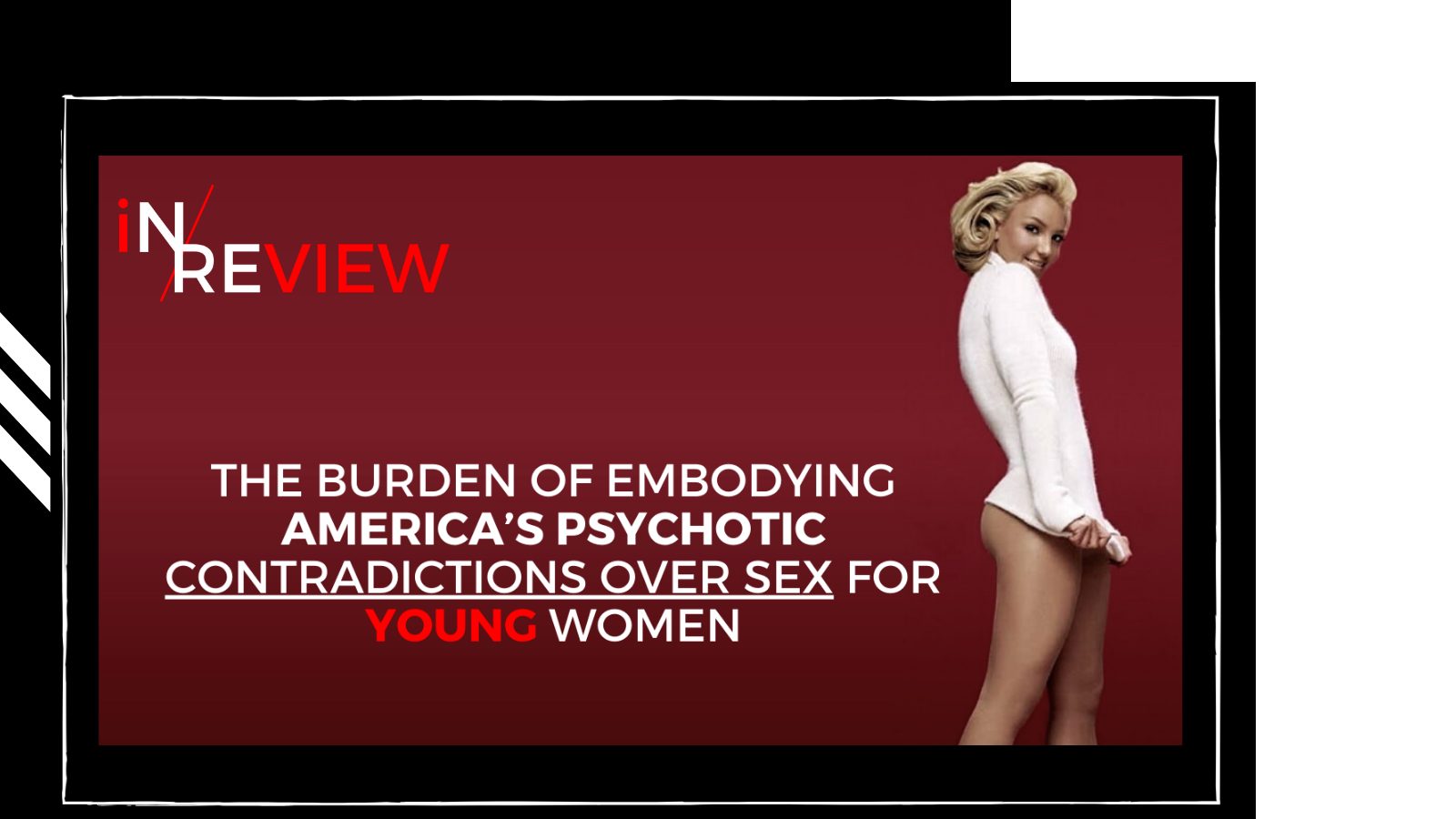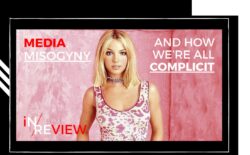NO SHORTAGE OF HORRIFYING MOMENTS
The betrayal of Britney Spears: how pop culture failed a superstar
The Guardian says in an effective new documentary, the difficult life of a pop star is examined from family struggles to the toll of being at the mercy of the media.
There is no shortage of horrifying, look-away-from-the-screen moments in Framing Britney Spears, the New York Times-produced documentary that examines, in succinct, bruising fashion, the pop star’s incendiary career and controversial legal guardianship.
The uncomfortable quality of these images and video is due, in large part, to their mundanity – a celebrity off-stage, doing unremarkable things; the paparazzi hordes that were a staple of the mid-2000s, at the height of TMZ, tabloid and gossip blog power; the familiarity of the whole circus, which exists in America’s collective cultural memory.
None of these images, none of this information about Britney’s stratospheric teenage fame, mental breakdown in 2008, and the legal conservatorship that has governed her daily life in the 13 years since, is new. We just don’t often sit with the evidence – not this cohesively, not this viscerally.
Perhaps unsurprisingly, given the nostalgic affection for Britney, the film has triggered an outpouring of horror and humility.
The film is another notch in a string of slow-rolling, ever-expanding reconsiderations of American celebrity culture, and particularly the female tabloid figures of the 90s and aughts, one facilitated by the larger #MeToo retelling of sex, power and the spectra of traumas faced by women, partly by the simple passage of time.
Spears carried the extra burden of embodying America’s psychotic contradictions over sex for young women – dress sexy but be virginal, convey that you want it but never, God forbid, know what you want, let alone get it; tread as closely to the line of actual sex as possible but never cross it.
She rocketed to fame in an era when Bill Clinton’s scandalous affair with Monica Lewinsky – another big tabloid story whose heroes and villains have been revised with the passage of time and #MeToo – brought the lewd discussion of sex, and the spectre of sex panic, back into the public sphere (and tasteless Jay Leno jokes).
Memory is a hazy, gauzy thing. You can remember, intellectually and in tabloid snippets, the frenzy over Spears in the mid-to-late aughts, but not recall the galling starkness of its imagery – a woman hunted and literally hounded by men across Los Angeles, the harried, vertigo-inducing funhouse of camera flashes. Spears’s meltdown was mundane enough to merit a category – what has Britney Spears lost this year? – on the gameshow Family Feud (answers included her mind, her children and her dignity). That detail was probably not memorable enough in 2008; it’s unforgettably crude now.
What is clear is our continued fixation with her, our collective culpability in even passing interest, the misogynistic, cruel cultural mores – whether for sex or mental health – that become clear in rearview, too late.

WE'RE ALL COMPLICIT
Sexualised, mocked, and fed to the wolves: why the Britney Spears story shames us all
The Telegraph says fans settled in to the New York Times’ documentary Framing Britney Spears, perhaps hoping for a bit of nostalgia, a touch of drama and some chance to remind themselves of the hectic period of Spears’ life when she was never off the front pages for all the wrong reasons. Instead, viewers were forced to reckon with their own role in the stars’ mistreatment at the hands of the media, her family, the legal system and popular culture as a whole.
If you were to write a guide on how not to interview a teenage girl, where would you start? Would you perhaps begin by insisting that the septuagenarian interviewer not ask their prepubescent subject if he could be her boyfriend? Would you suggest that, maybe, asking an 18-year-old girl about the status of her virginity should be off limits?
These lines of questioning would not fly today, not without uproar or, hopefully, the star feeling like she can push back and refuse to answer at the very least. But Britney was, in many ways, a trailblazer in this instance. She broke out during a period where boy bands ruled the roost; there were very few young, female stars who achieved the level of success that she did in the late 1990s. As someone releasing pure pop music she wasn’t taken seriously as an artist, dismissed as disposable music for girls and eye-candy for boys.
The Madonna/Whore hypocrisy has never been so overt as in the media’s treatment of Britney Spears in the early 2000s. In psychology, Sigmund Freud coined the term Madonna-Whore Complex to describe men who see women only as virginal and pure or sexual and debased. This is how popular culture saw Britney Spears: the good girl who they could not condone being a sexual being, even while constantly sexualising her.
It wasn’t just male interviewers who fed into it. The documentary includes footage of Britney Spears on Dateline in 2003, presented by Diane Sawyer. Sawyer manages to pester a 21-year-old Spears for intimate details of her sex life, tell her a Governor’s wife wants to shoot her for being a bad role model and insinuate that Spears has no one to blame but herself for the backlash after she and Timberlake broke up.
The documentary makes plain the toll that all of this has taken on Spears even before it reaches the truly upsetting events of 2007. In the interviews she did as a bright-eyed teen she is confident, sure of herself and her mind – by 2003, she is cautious. She looks tired, her make-up heavily and hastily applied, her pleasant facade dissolving into tears as the weight of the inappropriate questioning piles up.

All the misogynistic pearl-clutching ignored the fact that Spears was simply holding a mirror up to adolescent girlhood. It’s not unusual for teens to hike their skirts up and unbutton their school shirts as low as they can get away with; it’s not a heinous crime for teens to make out with each other, to explore their bodies as they age into maturity.
In 2007, Spears’ personal life descended into tabloid fodder. She was constantly hounded by paparazzi as public appetite for the fallout of her mental health issues reached fever pitch. The infamous head-shaving of 2007 is contextualised by the bitter custody battle that was raging between Spears and her one-time husband Kevin Federline. She was stuck in a vicious circle: she couldn’t escape the paparazzi but to avoid them meant being a prisoner in her own home.
The more she was seen, the more the public wanted to see her; the most chaotic her life became, the more the paparazzi goaded her toward breaking point. Her troubles were breathlessly reported, her struggles with her mental health becoming a punchline for talkshow hosts and quiz show rounds. Spears ended up being hospitalised for a spell; and this is when her father took over her affairs.
The one glimpse any of us have into her life as it is, is via her Instagram account. She seems fragile but happy; just getting on with the business of being herself, enjoying her indefinite hiatus from popstar life.
The story is far from at its end, but we are lucky that the wringer we put Britney Spears did not have a more tragic outcome. Others have not been so lucky: Amy Winehouse, who would no doubt hate to be compared to Britney, nevertheless has a lot in common with her. She, too, had a withholding father who ended up in charge of her affairs; few close friends; very public mental health issues; incessant press attention and cruel jokes made at the expense of her very serious problems.
Though we have begun to care for our young artists more, there are still ways that they are hounded and damaged by society and our actions within them: just look at Little Mix’s Jesy Nelson, who was moved to make an entire documentary about the ways that being in the public eye has impacted her mental health, before leaving her girl group altogether.
As traditional media falls in influence and we gain more individual and collective power through social media, it’s on all of us to learn from the many awful mistakes made with Britney Spears, to interrogate how we treat women in the public eye and to consider our own roles in these too-often tragic stories. We want our celebrities to be Teflon, for nothing we think or say to stick to them, but that simply isn’t the case.
In 20 years, if someone makes another documentary about another now-starlet, would our own behaviour pass muster? Right now, I doubt it.
ABUSE OF YOUNG STARS STILL HAPPENING

It’s Naive to Think the Creepy, Abusive Treatment Britney Spears Faced Isn’t Still Happening to Young Stars
InStyle says we’re granted the gift of hindsight while watching Framing Britney, the documentary on the many iterations of Britney Spears we’ve built up and torn down for sport in the arena of popular culture.
We’re able to peer 25 years into the past and condemn the media for gross violations of personal boundaries, for the sexualization of a teenage girl, and many wrong choices made at her expense, from the general down to the specific. The industry wanted her to be a school girl, but sexy; the media made her out to be a ‘slut’ and thus acted entitled to every part of her body. She suffered under the weight of those competing messages — and boom, was labeled insane.
A few weeks ago, I came across a video on TikTok of a young woman singing about trivial things she had felt ashamed to admit she loved. Among them was Taylor Swift.
Admitting that you like Taylor Swift has become something of a litmus test for other female artists, too. Meaning, they aren’t supposed to admit it when they do. “It used to be a shock to people that I liked Taylor Swift,” Phoebe Bridgers told Nylon last month. “I think she is the perfect example of the way that privilege is both really lucky, but also you have to be naturally talented … and you have to be a great writer, and I’ve always thought she was.” Bridgers, another blonde musician recently placed at the butt end of sexist ire, put the emphasis on Swift’s talent, because in the conversations about Taylor’s or Britney’s career, it’s often the element that’s lost.
When I was given the chance to think critically about the views I held of Britney, to examine where (and who) they came from, I didn’t. Not because I was too young to know better, but because it was more fun to join in on the game that used Britney (and Paris, and Lindsay, and any other young, successful, beautiful woman) as a punching bag. Doing so is the surest way to keep them at arm’s length — to prove you are a chill girl, and not like them at all. It’s the old “guys’ girl” trap.
In the meantime though, we shouldn’t stop at looking back at our collective mistreatment of Britney Spears. We should acknowledge our ignorance in the face of injustice put upon Megan Fox, who in 2009 recalled being sexualized by director Michael Bay when she was just 15 years old, only to have Jimmy Kimmel reply along the lines of ‘well, what did you expect’; or Janet Jackson, who famously took the fall for what was a two-party wardrobe malfunction at the 2004 Super Bowl halftime show; or Jennifer Aniston, whose divorce from Brad Pitt cast her as the scorned, sad, childless woman, in contrast to the role assigned to Angelina Jolie — the homewrecker.
Then, importantly, we have to admit this hasn’t only happened in the past. Can we honestly say the conversations around Billie Eilish’s body feel materially different from what Britney Spears endured at her age?

A NEW ERA?
Will Framing Britney Spears be a moment of reckoning for the celebrity media?
BBC News says the documentary has led to renewed criticism about her treatment within the bubble of 00s celebrity culture, and has sparked some soul-searching in the media.
Blogger Perez Hilton has similarly said he is “so sorry” for how he behaved.
My words and actions were wrong. I was nasty, mean, cruel, inconsiderate, awful. I have apologised to Britney not just publicly, but privately.”
Amid this reckoning, Spears’ treatment at the hands of the entertainment media machine now feels outdated in today’s climate – but has the celebrity experience really changed?
It’s hardly unusual for celebrities to face intrusion and a loss of privacy at the height of their fame.
We can see Britney within a long line of women artists – from Marilyn Monroe to Whitney Houston and Amy Winehouse – who have been judged, not so much for the work that they produce but for the way in which they have been represented by the press (Lucy Robinson, culture historian at the University of Sussex)
Nowhere was this clearer than during Britney’s 2003 television interview with US journalist Diane Sawyer.
“She’s like a laboratory experiment in the insulating power of relentless fame,” the broadcaster told viewers. “Remember, no high school or college life to practise dating, no anonymity for trial and error and embarrassing choices.”
Despite this apparent understanding, the tone of her questioning, which was persistent and accusatory in its focus on Britney’s relationships and sex life, left the then 21-year-old in tears.
A clear dehumanisation took place. A sense that Britney’s actions were seen as existing in a parallel universe to all of the stresses and pressures of being in the spotlight.
The judgement towards her was so socially acceptable too – think of all of the merch that mocked her breakdown, greetings cards and mugs about Britney surviving 2008. It feels so cheap to me, looking back.
Part of the subsequent shift in mindset stems from an increased understanding around mental health and the media’s role within in it – particularly following the death of Love Island presenter Caroline Flack last year.
A new era?
So, does this mean the treatment of celebrities is softening?
Commentator Mic Wright says the positive response to Jesy Nelson’s departure from girl group Little Mix last year, citing the need to protect her mental health, suggests the the media understands it can no longer be as “nakedly brutal”.
The tabloids know they need to pay lip service to mental health concerns and the right to a private life, but they still become obsessed with particular stars and put them under an enormous amount of pressure, he says.
But despite increased awareness, Hannah Davies isn’t entirely sure the celebrity ecosystem is necessary kinder – but simply evolving into a “new industrial complex” between traditional and new media.
I think we have a much better understanding of mental health now, but even so – watching Britney being harangued by paparazzi and seeing those headlines isn’t something that’s unique to the late 2000s.
We’re still seeing celebrities used and abused by the media, and the advent of reality TV and social has only made that surveillance more constant, and increased this conveyor belt of people whom the tabloids can support and then turn on.
Framing Britney Spears is available on Hulu. A UK air date is expected in Spring 2021.
DEEP DIVE
Britney Spears: fight over pop star’s conservatorship heads back to court – The Guardian
Britney Spears: 2007 video of Craig Ferguson refusing to mock singer goes viral – The Independent
Sarah Silverman regrets ‘unfortunate’ Britney Spears comments from 2007: ‘I wish I can delete it’ – The Independent
Framing Britney Spears: how her fans took on her controlling father – The Times
Britney Spears: Miley Cyrus and Sarah Jessica Parker among stars showing support over new documentary – Sky News
How complicit are we in the downfall of Britney Spears? – Baazar
Quick Facts
Forbes estimates the estate in question is worth about $60 million. Court documents reviewed by Forbes last year showed that Spears has $56.5 million invested in various brokerage accounts, businesses and real estate, while the rest is in cash.
https://www.instagram.com/p/CLIbxIuA9x1/
The Truth About Justin Timberlake And Britney Spears’ Breakup
Looking back it all makes sense.





